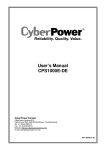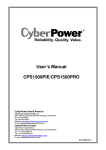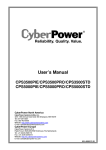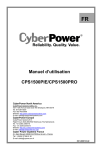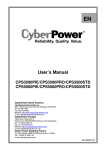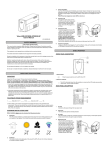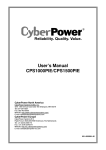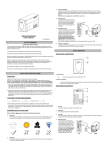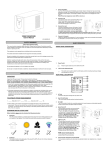Download CyberPower CPS600E User`s manual
Transcript
User’s Manual CPS600E CyberPower Europe CyberPower Systems B.V. Flight Forum 3545, 5657DW Eindhoven, The Netherlands Tel: +31 (0)40 2348170 Fax: +31 (0)40 2340314 Website: http://eu.cyberpowersystems.com/ E-mail: [email protected] K01-0000186-00 CPS600E Content SAFETY AND EMC INSTRUCTIONS ................................... 2 INSTALLING YOUR EPS ...................................................... 4 UNPACKING ......................................................................................... 4 AUTOMATIC VOLTAGE REGULATOR ............................................... 4 HARDWARE INSTALLATION GUIDE ................................................... 4 BASIC OPERATION .............................................................. 5 DESCRIPTION ..................................................................................... 5 REPLACING THE BATTERY ................................................ 6 DEFINITIONS FOR ILLUMINATED LCD .............................. 7 EPS STATUS INQUIRY AND FUNCTIONS SETUP ............. 8 GENERAL MODE ................................................................................. 8 SET-UP MODE ..................................................................................... 8 FAULT WARNING DISPLAY AND ALARM ........................ 10 TROUBLESHOOTING ......................................................... 11 TECHNICAL SPECIFICATIONS ......................................... 12 1 Copyright © 2010 CyberPower Systems, Inc. CPS600E SAFETY AND EMC INSTRUCTIONS This manual contains important safety instructions. Please read and follow all instructions carefully during installation and operation of the unit. Read this manual thoroughly before attempting to unpack, install, or operate your Emergency Power System (EPS). CAUTION! To prevent the risk of fire or electric shock, install in a temperature and humidity controlled indoor area free of conductive contaminants. (Please see specifications for acceptable temperature and humidity range). CAUTION! To reduce the risk of electric shock, do not remove the cover, except to service the battery. There are no serviceable parts inside, except for the battery. CAUTION! EPS must be connected to an AC power outlet with circuit breaker protection. Do not plug into an outlet that is not grounded. If you need to de-energize this equipment, turn off and unplug the unit. CAUTION! To avoid electrical shock, turn off the unit and unplug it from the AC power source before servicing EPS, replacing the external battery or installing equipment. CAUTION! To reduce the risk of fire, only connect the EPS to a circuit with 10 amperes maximum branch circuit over-current protection in accordance with the CE requirement. CAUTION! The building wiring socket outlet (shockproof socket outlet) must be easily accessible and close to the EPS. CAUTION! Please use only VDE-tested, CE-marked mains cable (e.g. the mains cable of your equipment) to connect the EPS to the building wiring socket outlet (shockproof socket outlet). CAUTION! Please use only VDE-tested, CE-marked power cables to connect the loads to the EPS. CAUTION! When installing the equipment, ensure that the sum of the leakage current of the EPS and the connected equipment does not exceed 3.5mA. CAUTION! Do not disconnect the mains cable on the EPS or the building wiring socket outlet (shockproof socket outlet) during operations since this would remove the protective ground of the EPS and of all connected loads. CAUTION! This is a class A product. In a domestic environment this product may cause radio interference in which case the user may be required to take adequate measures. DO NOT USE FOR MEDICAL OR LIFE SUPPORT EQUIPMENT! DO NOT use in any circumstance that would affect operation and safety of any life support equipment, any medical applications or patient care. DO NOT USE WITH OR NEAR AQUARIUMS! To reduce the risk of fire or electric shock, do not use with or near an aquarium. Condensation from the aquarium can cause the unit to short out. DO NOT INSTALL THE EPS WHERE IT WOULD BE EXPOSED TO DIRECT SUNLIGHT OR NEAR HEAT! DO NOT BLOCK OFF VENTILATION OPENINGS IN THE EPS’S HOUSING! Copyright © 2010 CyberPower Systems, Inc. 2 CPS600E SAFETY: EN62040-1-1 EMI: Conducted Emission: IEC/EN 62040-2…Category C2 Radiated Emission: IEC/EN 62040-2……Category C2 Harmonic Current: IEC/EN61000-3-2 Voltage Fluctuations and Flicker: IEC/EN61000-3-3 EMS: IEC/EN61000-4-2(ESD) IEC/EN61000-4-3(RS) IEC/EN61000-4-4(EFT) IEC/EN61000-4-5(lightning surge) IEC/EN61000-2-2 (Immunity to low frequency signals) 3 Copyright © 2010 CyberPower Systems, Inc. CPS600E INSTALLING YOUR EPS UNPACKING Inspect the EPS upon receipt. The box should contain the following: EPS unit x 1; User manual x 1; Input Power Cord x 1; DC Fuse x 2 AUTOMATIC VOLTAGE REGULATOR Utility power is inconsistent. The EPS increases low voltage to computer safe 220 volts. The EPS automatically provides battery backup (External battery connection required) if the voltage drops below 170 volts or exceeds 270 volts. HARDWARE INSTALLATION GUIDE 1. Your new EPS may be used immediately upon receipt. However, recharging the external battery for at least 8 hours is recommended to ensure that the battery’s maximum charge capacity is achieved. To recharge the external battery, simply leave the unit plugged into an AC outlet when EPS is ON. 2. DO NOT use with medical or life support equipment. DO NOT use with or near aquariums as condensation may cause the unit to short out. 3. After connecting the hard wires, plug the EPS into a 2 pole, 3 wire grounded receptacle (wall outlet). Make sure the wall branch outlet is protected by a fuse or circuit breaker and does not service equipment with large electrical demands (e.g. air conditioner, copier, etc…). The warranty prohibits the use of extension cords, outlet strips, and surge strips. 4. Press the power switch to turn the unit on. The power on indicator light will illuminate and the unit will beep once. 5. If an overload is detected, an audible alarm will sound and the unit will emit one long beep. To correct this, turn the EPS off and unplug the equipment from the AC outlet. Ensure that the equipment plugged into the outlet does not exceed the UPS unit’s rated capacity (600VA/420W for CPS600E). If the rated capacities of the unit are exceeded, an overload condition may occur and cause the UPS unit to shut down or the input fuse to blow. For more information, refer to the “Troubleshooting” section. 6. To maintain optimum battery charge performance, make the EPS plugged into an AC outlet at all times. 7. The UPS is designed for horizontal or wall-mount use only. To ensure safety, please follow the placement directions as shown below. Copyright © 2010 CyberPower Systems, Inc. 4 CPS600E BASIC OPERATION DESCRIPTION 1. Power Switch Used as the master on/off switch for equipment connected to the AC outlet. 2. Power On Indicator This LED is above the power switch. It illuminates when the utility condition is normal and the AC outlet is providing power, free of surges and spikes. 3. Multifunction LCD Readout High resolution and intelligent LCD display shows all the EPS information with icons and messages. For more information please check the DEFINITIONS FOR ILLUMINATED LCD INDICATORS section. 4. LCD Display Toggle / Selected Switch Users can monitor EPS status and set up functions using the toggle. The buzzer on/off can also be controlled by the toggle switch. Please refer to “EPS Status Inquiry and Functions Setup” section for more details. 5. AC Outlet The unit has one Schuko type outlet for connected equipment to ensure temporary uninterrupted operation during a power failure. Max. Output is 6.3A; Max. Output wattage is 420W. Note! Maximum cord length is 10 meters and the cable O.D. must be 14AWG or greater. 6. AC Inlet Connect to utility power through the input power cord. Note:The O.D. of the distribution cables must be 0.75mm or greater. Input Fuse The fuse provides optimal overload protection. Note:The Input Fuse is 6.3A/250V. 7. Black Battery Cable (Negative (-)) Connect black (negative (-)) battery cable to the black (negative (-)) connector on the external battery. Note: The Battery cable is 10AWG / 4 feet. 8. Red Battery Cable (Positive (+)) Connect red (positive (+)) battery cable to the red (positive (+)) connector on the external battery. Note: The Battery cable is 10AWG / 4 feet. 9. DC Fuse The fuse provides optimal overload protection for battery mode operation. 5 Copyright © 2010 CyberPower Systems, Inc. CPS600E REPLACING THE BATTERY CAUTION! Read and follow the IMPORTANT SAFETY INSTRUCTIONS before servicing the battery. Battery service should only be done by qualified professionals. CAUTION! Use only the specified type and number of external batteries. Please see the technical specifications for replacement batteries. CAUTION! The battery may present a risk of electrical shock. Do not dispose of battery in a fire as it may explode. Follow all local ordinances regarding proper disposal of batteries. Lead-acid batteries should be recycled. CAUTION! Do not open or mutilate the batteries. Released electrolyte is harmful to skin and eyes and may be toxic. CAUTION! A battery can present a high risk of short circuit current and electrical shock. Take the following precautions before replacing the battery: 1. Remove all watches, rings or other metal objects. 2. Only use tools with insulated handles. 3. Do not lay tools or metal parts on top of battery or any terminals. 4. Wear rubber gloves and boots. 5. Determine if the external battery is inadvertently grounded. If grounded, remove the source of ground. CONTACT WITH GROUNDED BATTERY CAN RESULT IN ELECTRICAL SHOCK! Copyright © 2010 CyberPower Systems, Inc. 6 CPS600E DEFINITIONS FOR ILLUMINATED LCD The LCD Display indicates a variety of EPS operational conditions. All descriptions apply when the EPS is plugged into an AC outlet and turned on or when the EPS is on battery. 1. INPUT VOLTAGE Meter: This meter measures the AC voltage that the EPS is receiving from the utility wall outlet. The EPS is designed, through the use of automatic voltage regulation, to continuously supply connected equipment with stable, 220 output voltage. In the event of a complete power loss, severe brownout or over-voltage the EPS will rely on its external battery to supply consistent 220 output voltage. The Input Voltage Meter can be used as a diagnostic tool to identify poor quality input power. 2. OUTPUT VOLTAGE Meter: This meter measures, the AC voltage that the EPS is providing to the computer. It displays normal line mode, AVR mode, and battery backup mode. 3. NORMAL MODE Icon: This icon will illuminate when the EPS is working under normal conditions. 4. ON BAT (On Battery) Icon: When a severe brownout or blackout, this icon appearing and an alarm (two short beeps) activated indicate that the EPS is working via its batteries. Once the batteries are running out of power, for a period of time, an alarm (two short beeps) will appear continuously. If this occurs, it is recommended that save your files and turn off your equipment manually as soon as possible. 5. SILENT MODE Icon: This icon appearing indicates that the buzzer does not beep in the silent mode until the low battery capacity. 6. OVER LOAD Icon: This icon appearing and an alarm activated indicate that the overload condition. To relieve the overload, unplug your equipment from the EPS outlets until the icon disappears and the alarm stops being activated. 7. LOAD CAPACITY: Load CAPACITY is also shown on the bar chart; equal 25% load capacity for each segment. 8. BATTERY VOLTAGE: BATT. VOLTAGE indicates the voltage of battery. 7 Copyright © 2010 CyberPower Systems, Inc. CPS600E EPS STATUS INQUIRY AND FUNCTIONS SETUP GENERAL MODE a. Press the “Display” button to check the status of the EPS Items Unit Input Voltage Output Voltage V V Load Capacity Battery Voltage % V b. Press and hold the Display toggle for 4 seconds. If the machine is in the Battery Mode, it enters the silent mode. Press again for 4 seconds and it will return to normal (buzzer) mode. If the machine is in the Line Mode, it proceeds to Self Test. c. If the Display toggle remains untouched for over 30 seconds, the LCD backlight will turn off automatically. SET-UP MODE Step 1: Hold the Display toggle for 10 seconds to enter the EPS set-up Mode. LCD icon 1, 2 lights indicate Set-Up Mode. Step 2: By pressing the Display toggle, users can switch between setup functions. User configurable functions are as follows: a. Delay Time: The time delay between switching from Battery Mode to Line Mode. There are 9 different settings. The default setting is 0 minute. Function description: The machine will switch from Battery Mode to Line Mode after the AC power transmission reaches stability within the preset delay time. b. Charging Current: The function adjusts the battery charging current according to the capacity of the connected batteries. It can be configured for 25, 50, 75, and 100%. The default setting is 100%. 100% indicates that charging current is about 10Amps. c. Nominal Output Voltage: Configures the correct electricity/voltage supplied in the area/country where the EPS will be used. 220V and 230V may be selected. The system default setting is 220V. Function description: AVR Dynamic Voltage Compensation works automatically based on the system voltage settings. d. Static Frequency Tolerance: There are 6 settings (1,2,4,6,8,10%), and the default setting is +/-10%. Copyright © 2010 CyberPower Systems, Inc. 8 CPS600E Function description: The settings may be adjusted to the quality of the electricity in use. e. Slew Rate: Also called Dynamic Frequency Tolerance. There are 5 different settings (0.25,0.5,1,2,4 Hz/Sec). The default value is 4Hz/sec. Function description: “Slew Rate” indicates the tolerance of a device in accepting frequency variances. The lower “Slew Rate” results in less tolerance but better protection for the connected loads. f. Low Battery Shutdown Voltage: This function adjusts the EPS shutdown point according to the battery voltage. The default setting is 10V (with load). g. Mode Select: The standard mode (setting: 2) and the robust mode (setting: 1) are provided to select. Using the generators is suggested to select the robust mode (setting: 1), and using the computers is suggested to select the standard mode (setting: 2). The settable items are sorted by unit as in the following table: Items Unit Delay Time Charging Current Min % Icon Lit ON BAT ON BAT Nominal Output Voltage Static Frequency Tolerance V % NORMAL MODE NORMAL MODE Slew Rate Low Battery Shutdown Voltage % V None ON BAT Mode Select None None Step 3: Press and hold the toggle for 4 seconds. When the icons blink, the value of each item can be changed by slightly pressing the toggle. Step 4: To save the value and return to general mode, press and hold the toggle for 4 seconds. Note: If the machine is left idle for over 30 seconds during setup, it will turn off the backlight and return to general mode automatically. Note: If user wants to return to general mode without saving changes, there are two methods: 1. Wait for the backlight to turn off 2. Press and hold the “Display” toggle for 10 seconds 9 Copyright © 2010 CyberPower Systems, Inc. CPS600E FAULT WARNING DISPLAY AND ALARM 1. 2. 3. 4. 5. Overheat Protection: The EPS output will be interrupted. After 30 seconds, the machine shuts down and the LCD display output voltage is zero. Over-Load Protection: :The EPS output will be interrupted. After 30 seconds, the machine shuts down and Over Load Icon lights on the LCD display. Battery Missing: :You should hear a long beep and Battery Indicator flashes。 Low Battery Protection: The EPS output will be interrupted. After 30 seconds, the machine shuts down and the LCD display output voltage is zero. The following table shows each corresponding warning message on the LCD display and the alarm reacts during the machine shut down: LCD Warning Display Over Load Icon Alarm Constant tone Condition Over Load Output-Off - Load exceed the rating of EPS. High Temperature Output-Off Zero Output Voltage Can Not Start Up Constant tone None Solution Check total load to confirm the rating of EPS. Check fans function and air vent clearances. Low Battery Output-Off -- Insufficient battery capacity. Recharge the battery. Over Charge or AVR Error-In Line Mode, battery is overcharged or AVR is faulty. Inform service agents. Short Output-Off -- Output Short Circuit Protection Check the EPS output to see if there is a short circuit. Line Input/ Output Error Output-Off -- incorrect Input/ Output connection Cold Start Battery High Voltage Output-Off -- the battery voltage is too high during cold start. Copyright © 2010 CyberPower Systems, Inc. Check Input/ connection. Output Check the reason for battery over-voltage. 10 CPS600E TROUBLESHOOTING Problem Possible Cause Input fuse is blown due to overload. Outlet does not provide power to equipment. DC fuse is blown due to overload. Batteries are discharged. Unit has been damaged by a surge or spike. The EPS does not perform expected runtime. The EPS will not turn on. Batteries are not fully charged. Batteries are degraded. The on/off switch is designed to prevent the damage that rapidly turns it off and on. The unit is not connected to an AC outlet. The battery is worn out. Mechanical problem. 11 Solution Turn the EPS off and unplug the connected equipment. Unplug the power cord of the EPS then remove the fuse compartment beneath the AC inlet of the EPS and replace the blown fuse with a spare one. Lock the compartment back to the EPS. Connect power cord then turn the EPS on. Make sure that your spare fuse meets the specification and the equipment plugged into the outlet does not exceed the UPS unit’s rated capacity. Servicing of the DC fuse should only be performed by trained personnel. For more information on DC fuse replacement, contact CyberPower Systems at [email protected] Recharge the unit for at least 4 hours. Contact CyberPower Systems about replacement batteries at [email protected] Recharge the battery by leaving the EPS plugged in. Contact CyberPower Systems about replacement batteries at [email protected] Turn the EPS off. Wait 10 seconds and then turn the EPS on. The unit must be connected to a 220/230V outlet. Contact CyberPower Systems about replacement batteries at [email protected] Contact CyberPower Systems via phone or visit our website at eu.cyberpowersystems.com Copyright © 2010 CyberPower Systems, Inc. CPS600E TECHNICAL SPECIFICATIONS Model Capacity (VA) Capacity (Watts) Operation Technology CPS600E 600VA 420W AVR ( Single Boost & Single Buck ) AC Input Input Voltage Range Input Frequency Range AC Output Number of Phase On Battery Typical Output Voltage Nominal Output Voltage Configuration Note On Battery Output Frequency Overload Protection Transfer Time 170Vac – 270Vac 45~65Hz (auto sensing) Single Phase 0 ~40% LOAD Pure Sine Wave at 220Vac +/- 5% 40~100% LOAD Trapezoidal Wave at 220Vac+/- 5% Configurable for 220 / 230Vac 50 / 60 Hz +/- 1% On Utility: Fuse On Battery: Internal Current Limiting < 10 ms ( Typical ) Output Receptacles External Battery Schuko Type * 1 Voltage x Recommended Rating x Quantity External Battery Rating 12V x 100Ah x 1 12V External Battery Type Sealed Maintenance Free Lead Acid Battery External Battery Protection Status Indication Indicators Audible Alarms Environmental Fuse Power On, LCD Display On Battery, Low Battery, Overload Operating Temperature Operating Relative Humidity 32°F to 104°F ( 0°C to 40°C ) 0 to 90% Non-Condensing Physical Dimensions (L*W*H)( mm ) 240 * 162 * 90 Weight (Kg) Agency 4.1 Certificated CE, SONCAP Copyright © 2010 CyberPower Systems, Inc. 12 CPS600E 13 Copyright © 2010 CyberPower Systems, Inc. CPS600E Copyright © 2010 CyberPower Systems, Inc. 14 CPS600E For more information, contact us at: CyberPower Europe CyberPower Systems B.V. Flight Forum 3545, 5657DW Eindhoven, The Netherlands Tel: +31 (0)40 2348170 Fax: +31 (0)40 2340314 Website: http://eu.cyberpowersystems.com/ E-mail: [email protected] Entire contents copyright © 2010 CyberPower Systems, Inc. All rights reserved. Reproduction in whole or in part without permission is prohibited. 15 Copyright © 2010 CyberPower Systems, Inc.

















